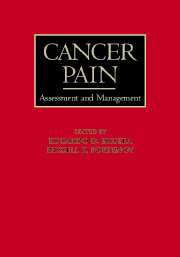Book contents
- Frontmatter
- Contents
- List of contributors
- Preface
- SECTION I MECHANISMS AND EPIDEMIOLOGY
- SECTION II ASSESSMENT AND SYNDROMES
- SECTION III PHARMACOLOGICAL TREATMENT
- SECTION IV NONPHARMACOLOGICAL APPROACHES
- SECTION V THE ROLE OF ANTINEOPLASTIC THERAPIES IN PAIN CONTROL
- SECTION VI PAIN IN SPECIAL POPULATIONS
- SECTION VII DIFFICULT PAIN PROBLEMS
- SECTION VIII SPECIAL TOPICS
- 25 Pain in medical illness: ethical foundations
- 26 Understanding clinical trials in pain research
- 27 Legal and regulatory aspects of opioid treatment: the United States experience
- 28 Role of family caregivers in cancer pain management
- Index
28 - Role of family caregivers in cancer pain management
from SECTION VIII - SPECIAL TOPICS
Published online by Cambridge University Press: 08 October 2009
- Frontmatter
- Contents
- List of contributors
- Preface
- SECTION I MECHANISMS AND EPIDEMIOLOGY
- SECTION II ASSESSMENT AND SYNDROMES
- SECTION III PHARMACOLOGICAL TREATMENT
- SECTION IV NONPHARMACOLOGICAL APPROACHES
- SECTION V THE ROLE OF ANTINEOPLASTIC THERAPIES IN PAIN CONTROL
- SECTION VI PAIN IN SPECIAL POPULATIONS
- SECTION VII DIFFICULT PAIN PROBLEMS
- SECTION VIII SPECIAL TOPICS
- 25 Pain in medical illness: ethical foundations
- 26 Understanding clinical trials in pain research
- 27 Legal and regulatory aspects of opioid treatment: the United States experience
- 28 Role of family caregivers in cancer pain management
- Index
Summary
Introduction
Family caregivers play a vital role in meeting the physical and psychosocial needs of patients with serious illness. The past 5 years have seen accelerating trends toward early hospital discharge, increasingly complex home-based treatment protocols, and the transformation of caregivers' role from promoting convalescence to participating actively in the accomplishment of treatment goals. In spite of the shift in care from the inpatient setting to the home, and the concomitant rise in the expectations of caregivers, the health care system has been slow to recognize the psychosocial and financial burden associated with caregiving.
It is estimated that more than 15 million adults currently provide care to relatives in the United States (1). Of these, most tend to be middle-aged children or older spouses, and predominantly female (2). Until recently, few studies had examined the role of family caregivers in pain management and palliative care, but this trend has changed within the past 5 years. Findings from recent landmark studies convey a picture of rising expectations and unmet needs for caregivers carrying out a variety of medical tasks at home (1–3). For example, Emanuel and colleagues (3) interviewed terminally ill adults and their caregivers to determine how their needs for assistance were being met. Unmet needs were reported by 87% of patients, who required help with transportation (62%), homemaking services (55%), nursing care (29%), and personal care (26%). Most patients relied completely on family and friends to provide this assistance; only 15% relied on paid assistance. For caregivers of cancer patients, such care may translate into 20 or more hours of care a week, the equivalent of a part-time (unpaid) job (2).
- Type
- Chapter
- Information
- Cancer PainAssessment and Management, pp. 467 - 474Publisher: Cambridge University PressPrint publication year: 2003
- 2
- Cited by



